An ancient estuary
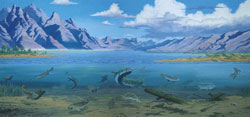
 (40 kb) A lake, a lagoon or an inland sea are among the ideas presented at some point or another. To shed light on the question, a comparison can be made between Miguasha fossils and those from other fossiliferous sites known to be of the same age.
(40 kb) A lake, a lagoon or an inland sea are among the ideas presented at some point or another. To shed light on the question, a comparison can be made between Miguasha fossils and those from other fossiliferous sites known to be of the same age. 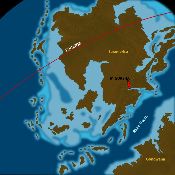
 (52 kb)The almost total absence of typical marine fossils led many researchers to assign a freshwater origin to the Escuminac Formation. The specialists who supported this idea took into account the fact that Miguasha displays strong sedimentary and faunal similarities with the Old Red Sandstone in Scotland, also considered to represent lake deposits.
(52 kb)The almost total absence of typical marine fossils led many researchers to assign a freshwater origin to the Escuminac Formation. The specialists who supported this idea took into account the fact that Miguasha displays strong sedimentary and faunal similarities with the Old Red Sandstone in Scotland, also considered to represent lake deposits.However, since the early 1980’s, perceptions began to change. Recent studies have confirmed the presence of rare but convincing clues of marine influence. These include the remains of polychaete worms, trace fossils, and acritarchs. And even if most of the fish species found at Miguasha seem to have tolerated a wide variety of environments compared to those found in other Devonian sites, some are quite typical of a marine environment, like the placoderm Plourdosteus.

 (44 kb)The marine influence also left its mark in the chemistry of the Escuminac Formation sediments and of the bones contained within them. Variant forms of chemical elements called isotopes are found in proportions that are distinctive of the original environment, whether it be saltwater or freshwater. At Miguasha, the ratios of strontium isotopes (86Sr and 87Sr) in preserved fish bones, as well as those of oxygen (18O and 16O) and carbon (13C and 12C) in the sediments fall within the typical range for Devonian oceans.
(44 kb)The marine influence also left its mark in the chemistry of the Escuminac Formation sediments and of the bones contained within them. Variant forms of chemical elements called isotopes are found in proportions that are distinctive of the original environment, whether it be saltwater or freshwater. At Miguasha, the ratios of strontium isotopes (86Sr and 87Sr) in preserved fish bones, as well as those of oxygen (18O and 16O) and carbon (13C and 12C) in the sediments fall within the typical range for Devonian oceans.In light of this collective evidence, it is clear that the outflow basin of the Escuminac Formation was in contact with the sea. But the degree to which it was exposed it was to saltwater is difficult to determine considering the atypical faunal assemblages found at Miguasha compared to those of purely marine Devonian environments.
An estuarial environment, which represents a transitional zone between freshwater and the waters of an open sea, must satisfactorily reconcile the faunal, sedimentological and geochemical evidence. Of course this scenario calls into question the proposed origins for the famous Old Red Sandstone in many locations.
The exposure of the Miguasha Group in regions as far away as New Richmond, some fifty kilometres from Miguasha, suggests that the ancient Miguasha estuary extended a considerable distance from the Baie des Chaleurs. It was part of a major drainage system on the southwest margin of the Euramerican continent, as demonstrated by the recent discovery of the Upper Devonian Holoptychius fish in southern New Brunswick.
The ancient Miguasha estuary seems to have occupied a vast area along the margin of the young Appalachian mountain chain, from which it flowed toward the Rheic Ocean. Perhaps it is not an exaggeration to compare Miguasha with the great Mississippi, Amazon or Nile estuaries. It lay in a lowlands zone, which later hosted a great alluvial plain that extended into an arm of the Rheic Ocean during Carboniferous time, even as the ocean was closing.
Site map | Feedback | Links | Sources | Credits
An ancient estuary
<< Biostratigraphy | An environment of exceptional preservation >>
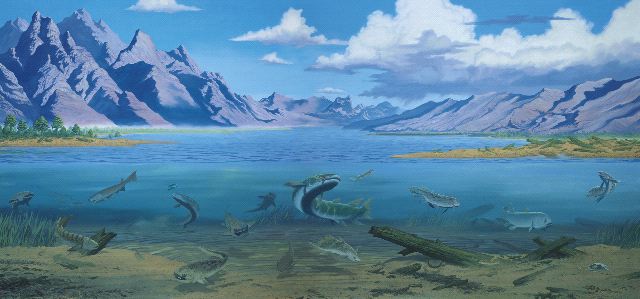
Title: The Miguasha paleoestuary
Author: Illustration by François Miville-Deschênes
Sources: Parc national de Miguasha
Year: 2003
Description:
A fresco of the ancient Miguasha estuary with the peaks of the young Appalachian mountain range in the background. The fish fauna were diversified, but it was Eusthenopteron foordi that dominated this watery world. Vegetation was concentrated along the shore, dense and tall enough in places to make forests.
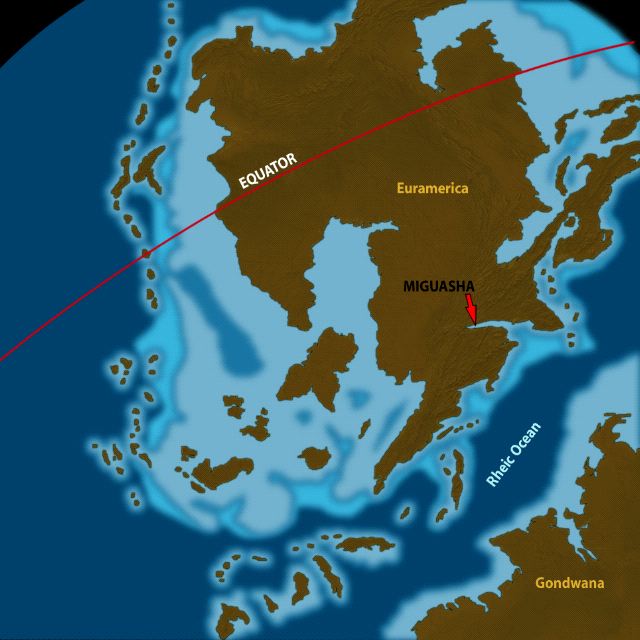
Title: Location of the ancient estuary of Miguasha
Author: François Bienvenue
Sources: Ron Blakey (http://jan.ucc.nau.edu/~rcb7)
Year: 2007
Description:
During the Upper Devonian, the source of the ancient estuary originated in the young Appalachian Mountains newly formed at the southeastern boundaries of the continent of Euramerica. The position of the ancient continental landmasses is by Ron Blakey (http://jan.ucc.nau.edu/~rcb7)
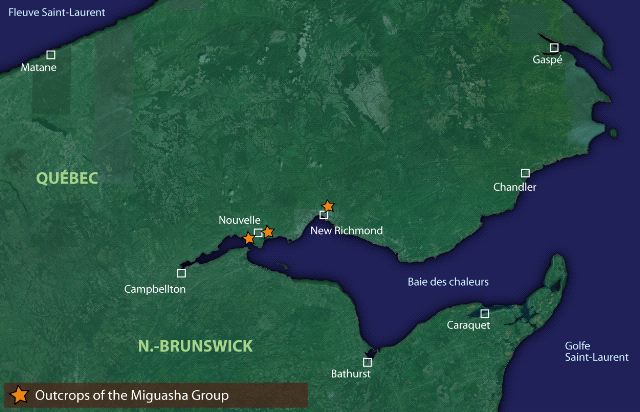
Title: Distribution of the Miguasha Group
Author: François Bienvenue
Sources: Parc national de Miguasha
Year: 2007
Description:
Location of the principle outcrops of the Miguasha Group along Quebec’s boundaries in Baie-des-Chaleurs. The recent discovery of the Fleurant and Escuminac formations in the New Richmond area east of Miguasha involves a very extensive sedimentary system.


